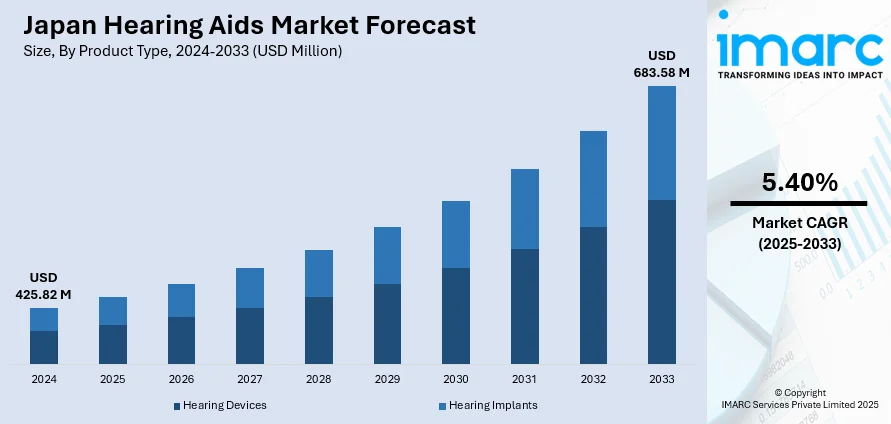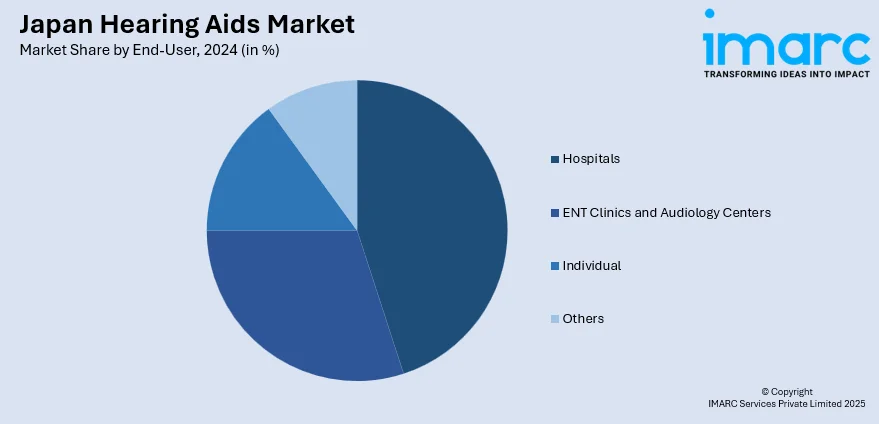
Japan Hearing Aids Market Size, Share, Trends and Forecast by Product Type, Hearing Loss, Patient Type, Technology Type, End-User, and Region, 2025-2033
Japan Hearing Aids Market Overview:
The Japan hearing aids market size reached USD 425.82 Million in 2024. Looking forward, IMARC Group expects the market to reach USD 683.58 Million by 2033, exhibiting a growth rate (CAGR) of 5.40% during 2025-2033. The market is driven by rapid technological advancements such as AI-powered and Bluetooth-enabled hearing aids provide convenience to users and appeal to Japan's technology-oriented consumers. Government subsidies and insurance coverage further enhance the accessibility for the elderly, while awareness campaigns reduce stigma and encourage early adoption of these products. All these factors, along with increased telehealth integration and discreet device innovations, are augmenting the Japan hearing aids market share.
|
Report Attribute
|
Key Statistics
|
|---|---|
|
Base Year
|
2024
|
|
Forecast Years
|
2025-2033
|
|
Historical Years
|
2019-2024
|
| Market Size in 2024 | USD 425.82 Million |
| Market Forecast in 2033 | USD 683.58 Million |
| Market Growth Rate 2025-2033 | 5.40% |
Japan Hearing Aids Market Trends:
Increasing Demand for Smart and Connected Hearing Aids
The market is witnessing a growing demand for smart and connected hearing aids, driven by technological advancements and an aging population. Modern hearing aids now integrate Bluetooth, AI, and smartphone compatibility, allowing users to adjust settings via mobile apps, stream audio directly, and monitor hearing health in real time. This trend aligns with Japan's tech-savvy consumer base, which values innovation and convenience. Additionally, telehealth services are becoming more prevalent, enabling remote adjustments and consultations, which is particularly beneficial for elderly users with limited mobility. In Japan, utilization patterns for healthcare have been altered after the pandemic, with inpatient volumes for both general and psychiatric care remaining 7.8% and 8% below pre-pandemic levels through November 2023. As Japan's healthcare system changes, the role of telemedicine in facilitating access to hearing aid consultations is likely to increase, thereby providing patients with a broader range of options. In addition to this, manufacturers are focusing on developing smaller, more discreet devices with enhanced connectivity features to cater to younger users with hearing loss. As wearable technology continues to change, the adoption of AI-powered hearing aids that adapt to different sound environments is expected to rise, further enhancing market growth.

Government Support and Rising Awareness of Hearing Health
The increasing government initiatives and public awareness campaigns promoting hearing health are supporting the Japan hearing aids market growth. With a rapidly aging population, over 28% of Japanese citizens are aged 65 or older, hearing loss has become a significant public health concern. Japan's elderly population has reached a record 36.25 million, representing nearly 30% of the total population. Japan faces rising healthcare and welfare costs, particularly as the aging population continues to grow. This shift in demographics highlights the growing demand for hearing aids and related healthcare services, presenting a clear opportunity for Japan's healthcare market. Apart from this, the Japanese government has implemented subsidy programs and insurance coverage expansions to make hearing aids more accessible, particularly for seniors. Additionally, public awareness campaigns by healthcare providers and NGOs emphasize early diagnosis and treatment, reducing the stigma associated with hearing aid usage. Companies are also collaborating with medical institutions to offer free hearing tests and educational seminars. As a result, more individuals are seeking hearing solutions, thereby driving market expansion. This trend is expected to continue as Japan's elderly demographic grows, further increasing demand for affordable and advanced hearing aid solutions.
Japan Hearing Aids Market Segmentation:
IMARC Group provides an analysis of the key trends in each segment of the market, along with forecasts at the country and regional levels for 2025-2033. Our report has categorized the market based on product type, hearing loss, patient type, technology type, and end-user.
Product Type Insights:
- Hearing Devices
- Behind-the-Ear (BTE)
- Receiver-in-the Ear (RITE)
- In-the-Ear (ITE)
- Canal Hearing Aids (CHA)
- Others
- Hearing Implants
- Cochlear Implants
- BAHA Implants
The report has provided a detailed breakup and analysis of the market based on the product type. This includes hearing devices (behind-the-ear (BTE), receiver-in-the ear (RITE), in-the-ear (ITE), canal hearing aids (CHA), and others), and hearing implants (cochlear implants and BAHA implants).
Hearing Loss Insights:
- Sensorineural Hearing Loss
- Conductive Hearing Loss
A detailed breakup and analysis of the market based on the hearing loss have also been provided in the report. This includes sensorineural hearing loss and conductive hearing loss.
Patient Type Insights:
- Adults
- Pediatrics
The report has provided a detailed breakup and analysis of the market based on the patient type. This includes adults and pediatrics.
Technology Type Insights:
- Analog
- Digital
A detailed breakup and analysis of the market based on the technology type have also been provided in the report. This includes analog and digital.
End-User Insights:

- Hospitals
- ENT Clinics and Audiology Centers
- Individual
- Others
The report has provided a detailed breakup and analysis of the market based on the end-user. This includes hospitals, ENT clinics and audiology centers, individual, and others.
Regional Insights:
- Kanto Region
- Kansai/Kinki Region
- Central/ Chubu Region
- Kyushu-Okinawa Region
- Tohoku Region
- Chugoku Region
- Hokkaido Region
- Shikoku Region
The report has also provided a comprehensive analysis of all the major regional markets, which include Kanto Region, Kansai/Kinki Region, Central/ Chubu Region, Kyushu-Okinawa Region, Tohoku Region, Chugoku Region, Hokkaido Region, and Shikoku Region.
Competitive Landscape:
The market research report has also provided a comprehensive analysis of the competitive landscape. Competitive analysis such as market structure, key player positioning, top winning strategies, competitive dashboard, and company evaluation quadrant has been covered in the report. Also, detailed profiles of all major companies have been provided.
Japan Hearing Aids Market News:
- September 09, 2024: Apple also launched groundbreaking health features, including the world's first-ever over-the-counter Hearing Aid feature in AirPods Pro 2, designed for individuals with mild to moderate hearing loss. The new feature, clinically validated, will be available in Japan and over 100 regions by the end of fall 2024. Additionally, the Apple Watch now includes sleep apnea notifications along with further enhancements to its global health capabilities, including in Japan.
Japan Hearing Aids Market Report Coverage:
| Report Features | Details |
|---|---|
| Base Year of the Analysis | 2024 |
| Historical Period | 2019-2024 |
| Forecast Period | 2025-2033 |
| Units | Million USD |
| Scope of the Report |
Exploration of Historical Trends and Market Outlook, Industry Catalysts and Challenges, Segment-Wise Historical and Future Market Assessment:
|
| Product Types Covered |
|
| Hearing Losses Covered | Sensorineural Hearing Loss, Conductive Hearing Loss |
| Patient Types Covered | Adults, Pediatrics |
| Technology Types Covered | Analog, Digital |
| End-Users Covered | Hospitals, ENT Clinics and Audiology Centers, Individual, Others |
| Regions Covered | Kanto Region, Kansai/Kinki Region, Central/ Chubu Region, Kyushu-Okinawa Region, Tohoku Region, Chugoku Region, Hokkaido Region, Shikoku Region |
| Customization Scope | 10% Free Customization |
| Post-Sale Analyst Support | 10-12 Weeks |
| Delivery Format | PDF and Excel through Email (We can also provide the editable version of the report in PPT/Word format on special request) |
Key Questions Answered in This Report:
- How has the Japan hearing aids market performed so far and how will it perform in the coming years?
- What is the breakup of the Japan hearing aids market on the basis of product type?
- What is the breakup of the Japan hearing aids market on the basis of hearing loss?
- What is the breakup of the Japan hearing aids market on the basis of patient type?
- What is the breakup of the Japan hearing aids market on the basis of technology type?
- What is the breakup of the Japan hearing aids market on the basis of end-user?
- What is the breakup of the Japan hearing aids market on the basis of region?
- What are the various stages in the value chain of the Japan hearing aids market?
- What are the key driving factors and challenges in the Japan hearing aids market?
- What is the structure of the Japan hearing aids market and who are the key players?
- What is the degree of competition in the Japan hearing aids market?
Key Benefits for Stakeholders:
- IMARC’s industry report offers a comprehensive quantitative analysis of various market segments, historical and current market trends, market forecasts, and dynamics of the Japan hearing aids market from 2019-2033.
- The research report provides the latest information on the market drivers, challenges, and opportunities in the Japan hearing aids market.
- Porter's five forces analysis assist stakeholders in assessing the impact of new entrants, competitive rivalry, supplier power, buyer power, and the threat of substitution. It helps stakeholders to analyze the level of competition within the Japan hearing aids industry and its attractiveness.
- Competitive landscape allows stakeholders to understand their competitive environment and provides an insight into the current positions of key players in the market.
Need more help?
- Speak to our experienced analysts for insights on the current market scenarios.
- Include additional segments and countries to customize the report as per your requirement.
- Gain an unparalleled competitive advantage in your domain by understanding how to utilize the report and positively impacting your operations and revenue.
- For further assistance, please connect with our analysts.
 Request Customization
Request Customization
 Speak to an Analyst
Speak to an Analyst
 Request Brochure
Request Brochure
 Inquire Before Buying
Inquire Before Buying




.webp)




.webp)












